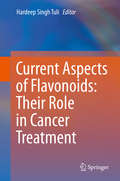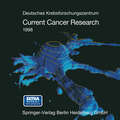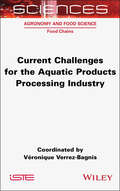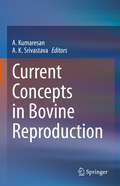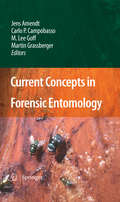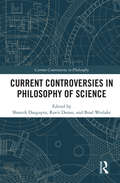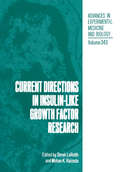- Table View
- List View
Current Applications of Pharmaceutical Biotechnology (Advances in Biochemical Engineering/Biotechnology #171)
by Ana Catarina Silva João Nuno Moreira José Manuel Sousa Lobo Hugo AlmeidaThis book offers an authoritative review of biopharmaceuticals and their clinical relevance. Biopharmaceuticals have been showing high therapeutic potential by means of biological and biosimilar medicines, particularly for the treatment of cancer, chronic diseases (e.g. diabetes, Crohn's disease, psoriasis and rheumatoid arthritis), neurodegenerative disorders (e.g. multiple sclerosis), and they have also been contributing to the progress of innovative therapies such as assisted reproductive medicine. Since the eighties, several biopharmaceuticals have been approved and, due to patents expiration, many biosimilars are also marketed.In this book, readers will find the most relevant updated information about the main clinical applications of pharmaceutical biotechnology. The authors provide expert analysis about the industrial challenges of recombinant proteins and the different classes of biopharmaceuticals, including monoclonal antibodies, vaccines, growth factors and stem cells. Topics such as bioprinting technologies in tissue engineering, gene therapy and personalized medicine are also covered in this book. Professionals, students and researchers interested in this field will find this work an important account.
Current Aspects of Flavonoids: Their Role in Cancer Treatment
by Hardeep Singh TuliThe book comprehensively introduces readers to various aspects of flavonoids, a category of natural metabolites that exhibits various pharmacological effects. It discusses their chemistry, absorption and metabolism, mechanisms of action and toxicology as well as future perspectives for clinical applications, and also provides detailed insights into their anti-cancer properties, since flavonoids are known to modulate tumor-associated intracellular as well as extracellular signaling pathways. The book also highlights the current research on the health effects of selected flavonoids, and their various roles in cancer prevention and treatment. Lastly, the book elucidates nanotechnology-mediated tools to enhance the bioavailability and solubility of flavonoids to improve their bioactivity and pharmacokinetic parameters.
Current Aspects of Neutrino Physics
by David O. CaldwellThis book, written by leading experts of the field, gives an excellent up-to-date overview of modern neutrino physics and is useful for scientists and graduate students alike. The book starts with a history of neutrinos and then develops from the fundamentals to the direct determination of masses and lifetimes. The role of neutrinos in fundamental astrophysical problems is discussed in detail.
Current Challenges for the Aquatic Products Processing Industry
by Véronique Verrez-BagnisThis book offers a state-of-the-art analysis on the main challenges facing the aquatic products processing industry. The topics explored are particularly relevant to the issues faced by European consumers and processors, but the information provided within this book can be widely extrapolated. This book should be helpful for processors, fish traders, consumers, scientists and students. The first chapter is dedicated to the sociological definition of "fish" and consumers’ perceptions. The following chapters deal with the notions of quality sensu lato, biological risks and their control, as well as the risks linked to the pollution of oceans and ecosystems by microplastics. Two types of processes and processed products – smoked fish and surimi products – which are of great economic importance to the European market, are also presented. The process of adding value to co-products, including the "blue biorefinery" and the innovative pH-shift technology are also covered in this book.
Current Challenges for the Aquatic Products Processing Industry
by Véronique Verrez-BagnisThis book offers a state-of-the-art analysis on the main challenges facing the aquatic products processing industry. The topics explored are particularly relevant to the issues faced by European consumers and processors, but the information provided within this book can be widely extrapolated. This book should be helpful for processors, fish traders, consumers, scientists and students. The first chapter is dedicated to the sociological definition of "fish" and consumers’ perceptions. The following chapters deal with the notions of quality sensu lato, biological risks and their control, as well as the risks linked to the pollution of oceans and ecosystems by microplastics. Two types of processes and processed products – smoked fish and surimi products – which are of great economic importance to the European market, are also presented. The process of adding value to co-products, including the "blue biorefinery" and the innovative pH-shift technology are also covered in this book.
Current Challenges on Large Supramolecular Assemblies (Nato Science Series C: #519)
by Georges TsoucarisThe objectives of the ARW were: - identifying areas and highlighting approaches by which large Supramolecular (SM) Assemblies can be synthesised - reviewing and combining methods to characterise and analyse such assemblies. The first part of the ARW is devoted to reviewing synthetic achievements in recent years for several families of SM compounds, and to bringing out principles for crystal structure design, including novel quantum mechanical methods. Synthesis pertains both to the chemical synthesis of components for SM assembly, and to the subsequent assembly process based on complementarity and non-covalent interactions. The elaboration of multiple recognition "algorithms" concurrently employed (for instance, 1t-1t and hydrogen bonds) has recently reached a high degree of sophistication in the sequence: Molecules -7 Supermolecule -7 SM array -7 Crystal or Conglomerate Novel Large Assemblies comprise synthetic entities with molecular weight as high as 15000, and hybrid SM assemblies between synthetic molecules and DNA. Further developments are foreseen at a higher level of organisation, such as between supermolecules or with electromagnetic fields in photochemical processes. Creation of 2D Assemblies is now a powerful tool for creation and study of SM interactions. Moreover, much is to be learned in going from 2D to 3D assemblies in crystal growth and other forms of organisation such as micelles or liquid crystals. On the other hand, crystal engineering based on Molecular Recognition in the Crystal State leads to novel 2D assemblies occurring within predesigned crystal structures (hydrophobic organic clays or nanoporous networks).
Current Concepts in Bovine Reproduction
by A. Kumaresan A. K. SrivastavaThis book provides updated information on the current concepts in bovine reproduction. It describes the complex issues associated with fertility and infertility in bovines and suggests strategies for achieving high reproductive efficiency. It discusses topics related to the fertility trend in bovines, estrus detection, controlled breeding, postpartum uterine health, uterine infections, and its therapeutic management. The essential roles of metabolic hormones on gonadal functions and fertility are also covered. Additionally, the book presents new insights in maternal recognition of pregnancy in bovines and suggest nutritional strategies to improve reproductive efficiency. The chapters on male fertility provide current information on semen cryopreservation, sperm quality assessment and measures to improve sperm fertility. A special chapter on intricacies in buffalo semen cryopreservation and measures to improve the quality of cryopreserved sperm is also included in this book. Lastly, the book introduces the immunobiological roles of anti-microbial peptides during sperm transport in reproductive tract and epigenetic bearing on fertility. This book is an invaluable resource for veterinary scientists, students and practitioners to understand the current developments in bovine reproduction for improving reproductive efficiency.
Current Concepts in Forensic Entomology
by Jens Amendt M. Lee Goff Carlo P. Campobasso Martin GrassbergerForensic Entomology deals with the use of insects and other arthropods in medico legal investigations. We are sure that many people know this or a similar definition, maybe even already read a scientific or popular book dealing with this topic. So, do we really need another book on Forensic Entomology? The answer is 13, 29, 31, 38, and 61. These are not some golden bingo numbers, but an excerpt of the increasing amount of annual publications in the current decade dealing with Forensic Entomology. Comparing them with 89 articles which were published d- ing the 1990s it illustrates the growing interest in this very special intersection of Forensic Science and Entomology and clearly underlines the statement: Yes, we need this book because Forensic Entomology is on the move with so many new things happening every year. One of the most attractive features of Forensic Entomology is that it is multid- ciplinary. There is almost no branch in natural science which cannot find its field of activity here. The chapters included in this book highlight this variety of researches and would like to give the impetus for future work, improving the dev- opment of Forensic Entomology, which is clearly needed by the scientific com- nity. On its way to the courtrooms of the world this discipline needs a sound and serious scientific background to receive the acceptance it deserves.
Current Concepts in Medical Research and Practice (Advances in Experimental Medicine and Biology #1039)
by Mieczyslaw PokorskiChange is an inherent feature of all aspects of clinical practice and patient management. This book seeks to contribute to presenting novel knowledge in various fields of clinical work. The articles tackle transdisciplinary topics and focus on the underlying mechanisms of clinical disorders, their prevention and management. The themes addressed include allergy and pseudoallergy in the pediatric population, influenza-related infections and their sequelae, which continues to be a scourge in the developing world, the risk of lung cancer repeats and their management, viral hepatitis that may lead to hepatocarcinoma, respiratory consequences of diaphragmatic hernias, disorders of steroid hormone metabolism, and others. The articles bring the updated strategies, research, and best practices to improve outcomes and to deliver state-of-the-art clinical care to patients. The book will be of interest to physicians, academic scientists, and researchers who are keen in sharing the latest medical practice developments.
Current Controversies in Philosophy of Science (Current Controversies in Philosophy)
by Shamik DasguptaCurrent Controversies in Philosophy of Science asks twelve philosophers to debate six questions that are driving contemporary work in this area of philosophy. The questions are:I. Are Boltzmann Brains Bad?II. Does Mathematical Explanation Require Mathematical Truth?III. Does Quantum Mechanics Suggest Spacetime is Nonfundamental?IV. Is Evolution Fundamental When It Comes to Defining Biological Ontology?V. Is Chance Ontologically Fundamental?VI. Are Sexes Natural Kinds?These debates explore the philosophical foundations of particular scientific disciplines, while also examining more general issues in the philosophy of science. The result is a book that’s perfect for the advanced philosophy student, building up their knowledge of the foundations of the field and engaging with its cutting-edge questions. Preliminary descriptions of each chapter, annotated lists of further readings for each controversy, and study questions for each chapter help provide clearer and richer snapshots of active controversies for all readers.
Current Controversies in Philosophy of Science (Current Controversies in Philosophy)
by Shamik Dasgupta Ravit Dotan Brad WeslakeCurrent Controversies in Philosophy of Science asks twelve philosophers to debate six questions that are driving contemporary work in this area of philosophy. The questions are:I. Are Boltzmann Brains Bad?II. Does Mathematical Explanation Require Mathematical Truth?III. Does Quantum Mechanics Suggest Spacetime is Nonfundamental?IV. Is Evolution Fundamental When It Comes to Defining Biological Ontology?V. Is Chance Ontologically Fundamental?VI. Are Sexes Natural Kinds?These debates explore the philosophical foundations of particular scientific disciplines, while also examining more general issues in the philosophy of science. The result is a book that’s perfect for the advanced philosophy student, building up their knowledge of the foundations of the field and engaging with its cutting-edge questions. Preliminary descriptions of each chapter, annotated lists of further readings for each controversy, and study questions for each chapter help provide clearer and richer snapshots of active controversies for all readers.
Current Debates in Philosophy of Science: In Honor of Roberto Torretti (Synthese Library #477)
by Cristián SotoThis volume collects previously unpublished contributions to the philosophy of science. What brings them together is a twofold goal: first and foremost, celebrating the name of Roberto Torretti, whose works in this and other areas have had –and continue to have– a significant impact on the international philosophy of science community; and second, the desire of advancing novel perspectives on various issues in the philosophy of science broadly construed. Roberto Torretti has made substantial contributions to current debates in the history and philosophy of science, the general philosophy of science, and the philosophy of physics and geometry. Among his landmark contributions, we find his investigations in the history and philosophy of geometry, as well as his systematic studies of Einstein's relativity theory. This volume convenes leading philosophers and early-career scholars compiling a fine collection of chapters addressing recent debates on Kantian philosophy of science, the general philosophy of science, and the history and philosophy of physics and mathematics.
Current decreases as resistance increases (large print)
by RnibThis page has two images. The top half of the page shows a circuit diagram with a closed switch, a cell, a lamp and an ammeter. To the right is a readout from the ammeter. The bottom half of the page shows a circuit diagram with a closed switch, a cell, two lamps and an ammeter. To the right is a readout from the ammeter. There is a locator dot shown, which will be at the top left of the page when the image is the correct way up. The diagrams use standard symbols to represent electrical components: the cells each have vertical parallel lines; each lamp is shown as a circle with a diagonal cross inside. The three ammeters are each shown as a circle with a capital print A inside. The circuits wiring is represented by solid black lines. In the circuit at the bottom of the page with two lamps, the total resistance is higher than the circuit at the top of the page with one lamp. As a result, the current flow is less in the bottom circuit.
Current decreases as resistance increases (UEB contracted)
by RnibThis page has two images. The top half of the page shows a circuit diagram with a closed switch, a cell, a lamp and an ammeter. To the right is a readout from the ammeter. The bottom half of the page shows a circuit diagram with a closed switch, a cell, two lamps and an ammeter. To the right is a readout from the ammeter. There is a locator dot shown, which will be at the top left of the page when the image is the correct way up. The diagrams use standard symbols to represent electrical components: the cells each have vertical parallel lines; each lamp is shown as a circle with a diagonal cross inside. The three ammeters are each shown as a circle with a capital print A inside. The circuits wiring is represented by solid black lines. In the circuit at the bottom of the page with two lamps, the total resistance is higher than the circuit at the top of the page with one lamp. As a result, the current flow is less in the bottom circuit.
Current decreases as resistance increases (UEB uncontracted)
by RnibThis page has two images. The top half of the page shows a circuit diagram with a closed switch, a cell, a lamp and an ammeter. To the right is a readout from the ammeter. The bottom half of the page shows a circuit diagram with a closed switch, a cell, two lamps and an ammeter. To the right is a readout from the ammeter. There is a locator dot shown, which will be at the top left of the page when the image is the correct way up. The diagrams use standard symbols to represent electrical components: the cells each have vertical parallel lines; each lamp is shown as a circle with a diagonal cross inside. The three ammeters are each shown as a circle with a capital print A inside. The circuits wiring is represented by solid black lines. In the circuit at the bottom of the page with two lamps, the total resistance is higher than the circuit at the top of the page with one lamp. As a result, the current flow is less in the bottom circuit.
Current Developments in Atomic, Molecular, and Chemical Physics with Applications
by Man MohanProceedings of an International Conference on Current Developments in Atomic, Molecular, and Chemical Physics with Applications, held March 20-22, 2002, in Delhi, India. The 38 chapters cover a broad range of research activities categorized into four sub-topics, namely: * Processes in Laser Fields, * Chemical Physics, * Collision Processes, * Atomic Structure and Applications.
Current Developments in Bioerosion (Erlangen Earth Conference Series)
by Max Wisshak Leif TapanilaIt has become apparent from the literature that bioerosional processes affect a wide range of biological and geological systems that cross many disciplines among the sciences. This book is dedicated to crossing those traditional disciplinary boundaries to present a united and current perspective on the pattern and process of bioerosion. The book opens with papers on the evolutionary significance of bioerosion. It concludes with a primer on the bioerosion bibliography website.
Current Developments in Solid-state Fermentation
by Ashok Pandey Christian Larroche Carlos Ricardo SoccolOver the period of last two decades, there has been significant resurgence in solid-state fermentation due to the numerous benefits it offers, especially in the engineering and environmental aspects. SSF has shown much promise in the development of several bioprocesses and products. This resurgence gained further momentum during the last 5-6 years with the developments in fundamental and applied aspects. A good deal of information has been generated in published literature and patented information. Several commercial ventures have come up based on SSF in different parts of the world. The contents are organized into four parts: Part 1 deals with the General and Fundamentals aspects of SSF; Part 2 deals with the production of bulk chemicals and products such as enzymes, organic acids, spores and mushrooms in SSF; Part 3 is on the use of SSF for specialty chemicals such as gibberellic acid, antibiotics and other pharmaceutically valuable secondary metabolites, pigments, and aroma compounds; Part 4 deals with the use of SSF miscellaneous application such as SSF for food and feed applications, agro-industrial residues as substrates in SSF and the production of silage and vermicompost.
Current Developments in Solid State NMR Spectroscopy
by Norbert Müller R. R. Ernst Perunthiruthy K. MadhuWhy to apply solid-state NMR? - By now, we should have learned that NMR is mainly used for the study of molecules in solution, while x-ray diffraction is the method of choice for solids. Based on this fact, the two recent 'NMR-Nobelprizes' went indeed into the liquid phase: my own one eleven years ago, and particularly the most recent one to Kurt Wuthrich. His prize is beyond any doubts very well justified. His contribution towards the study of biomolecules in solution, in their native (or almost native) environment is truly monumental. We all will profit from it indirectly when one of our future diseases will be cured with better drugs, based on the insightful knowledge gained through liquid-state NMR. Two fields of NMR are still left out of the Nobel Prize game: magnetic reso nance imaging (MRI) and solid-state NMR. The disrespect for MRI in Stockholm is particularly difficult to understand; but this is not a subject to be discussed at the present place. Solid-state NMR is the third of the three great fields of NMR, powerful already today and very promising for the near future.
Current Directions in Insulin-Like Growth Factor Research (Advances in Experimental Medicine and Biology #343)
by Mohan K. Raizada DerekRoithThe study of the insulin-like growth factor (IGF) family has become an exciting area of investigation. Initially, this family consisted of ligands (insulin, IGF-I and IGF-m and receptors (the insulin receptor, the type I or IGF-I receptor and the type II or IGF-IYM-6-P receptor). Subsequently, it was discovered that six specific binding proteips (lGFBPs 1-6) playa major role in the actions of this growth factor family. In addition, there are now more potential receptors when one considers the possible roles of the insulin-receptor related receptor (IRR) and hybrid receptor dimers composed of insulin and IGF-I receptor (half-receptors). Another important aspect of this area of research is the realization that the IGFs are not only essential for normal growth and development but, in addition play an important role in the normal specialized function(s) of all tissues of the body, including the nervous system, skeleton, reproductive system, kidney, and the immune system, to name but a few. The development of recombi!tant human IGF-I for clinical testing has been a major breakthrough for investigators. Potential uses include wound healing, reversal of catabolic states, diabetes, bone remodeling, recovery from acute renal failure and many others. will determine both its use and its potential hazards.

